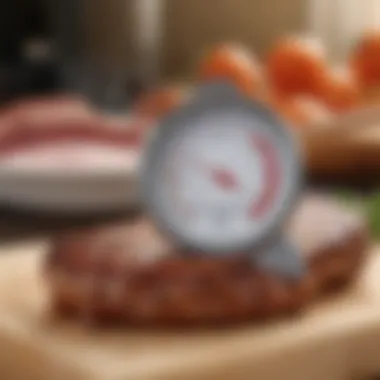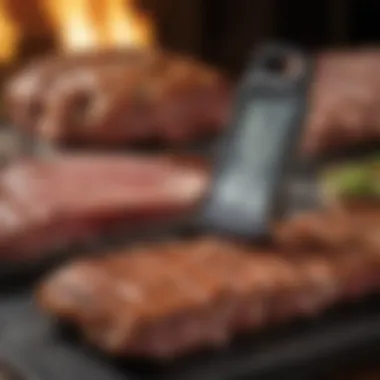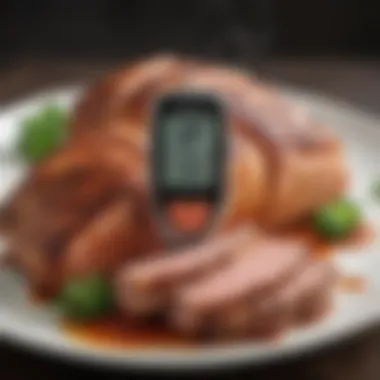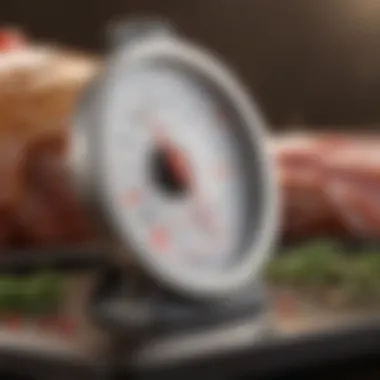Mastering Rotisserie Cooking with Wireless Thermometers


Intro
Wireless meat thermometers have revolutionized the way we approach rotisserie cooking. These devices provide accurate temperature readings without the need for cumbersome wires, allowing for greater flexibility and efficiency in the cooking process. A precise understanding of when meat reaches optimal doneness can make or break a culinary experience. This guide seeks to uncover the essential aspects of wireless thermometers, their advantages over traditional methods, and practical tips for maximizing their use in rotisserie cooking. We will delve into the technology that powers these devices, how to select the right thermometer, and also share methods to maintain them for longevity.
To navigate this journey, we aim to cater to food lovers of all ages, ensuring the insights provided are enriching and actionable. From the novice home cook to the seasoned chef, there is something valuable here for everyone looking to elevate their culinary delights.
Understanding Wireless Meat Thermometers
Wireless meat thermometers have become increasingly relevant in the culinary world, particularly for those who enjoy rotisserie cooking. Understanding how these devices work is essential for achieving the best possible results with your dishes. A wireless meat thermometer can greatly enhance your cooking experience by providing precise temperature readings without the constraints of traditional wired models. They allow for more freedom to move around while monitoring the doneness of your meat, ultimately leading to better control over your cooking process.
Definition and Functionality
A wireless meat thermometer is an electronic device designed to measure the internal temperature of meat. It consists of a probe that is inserted into the meat and a wireless transmitter that sends the temperature data to a receiver or a mobile device. The functionality is straightforward yet effective. Once the probe is inserted, you can set desired temperature ranges, and the device alerts you when the meat reaches the specified doneness. This accuracy is particularly crucial in rotisserie cooking, where external heat can create misleading perceptions about the meat's readiness.
Technology Behind Wireless Monitoring
The technology involved in wireless meat thermometers typically includes Bluetooth or Wi-Fi connectivity. Bluetooth models connect directly to your smartphone, allowing for real-time readings from a distance. Wi-Fi-enabled thermometers can connect to your home network, enabling monitoring from anywhere within the network range.
Key Technical Features:
- Temperature Sensors: These sensors are crucial for accurate readings. High-quality models provide a wide temperature range, making them versatile for various cooking styles.
- Mobile Applications: Many modern wireless thermometers come with companion apps that offer additional features such as cooking tips, temperature charts, and alerts if you stray too far from the grill or smoker.
- Battery Life: Extended battery life is a significant consideration for uninterrupted cooking sessions, especially during longer rotisserie cooking processes.
In summary, grasping the definition and technology behind wireless meat thermometers enriches our understanding of their function in the kitchen. Practical applications of this technology streamline the cooking experience, enhance precision, and promote better outcomes in culinary endeavors.
Advantages of Wireless Thermometers
Wireless meat thermometers have become essential tools in the realm of rotisserie cooking. Their advanced features enhance the cooking experience by addressing common pain points associated with traditional thermometers. This section examines the various benefits of utilizing wireless technology for grilling and roasting, emphasizing the specific advantages that contribute to more precise and efficient cooking.
Accuracy in Temperature Readings
Accuracy is paramount when it comes to cooking meat. Wireless thermometers are designed to provide precise internal temperature readings. This precision results from advanced sensor technology that can detect heat changes more quickly than conventional methods.
By relying on accurate temperature measurements, cooks can ensure that meat is cooked safely and to the desired doneness. Under-cooked meat poses health risks, while over-cooked meat can lead to dry and unappetizing dishes. Therefore, the accuracy of wireless thermometers directly impacts not just safety but also the quality and flavor of the food.
"An accurate reading is vital for achieving the ideal texture and juiciness in meats, making every meal a success."
Real-Time Monitoring
One of the notable features is the ability to monitor the cooking process in real-time. Most wireless meat thermometers come with mobile applications that allow users to check temperatures from a distance. This feature enables cooks to stay informed about the cooking process without constantly hovering around the grill or oven.
Real-time data helps in making informed decisions. For instance, if temperatures are rising too quickly, adjustments can be made immediately, preventing the risk of overcooking. Additionally, many models provide alerts and notifications, so cooks are promptly informed when their meat reaches the desired temperature. This convenience enhances the cooking experience significantly.
Convenience of Wireless Technology
The convenience factor cannot be overstated. Wireless thermometers eliminate the need for cords or wires, allowing for more freedom of movement around the cooking area. This wireless capability lets chefs focus on preparing side dishes or other aspects of their meals without being tethered to their cooking equipment.
Moreover, some thermometers allow for multiple probes. This means a user can cook different types of meat simultaneously, effectively streamlining the cooking process. The ability to manage diverse meat types at once adds tremendous value, especially during gatherings or special occasions. The simplicity of setup and operation only adds to their appeal, providing both novice and experienced cooks with an excellent tool for successful rotisserie cooking.
Selecting the Right Wireless Meat Thermometer
The selection of an appropriate wireless meat thermometer is essential for ensuring consistent and satisfying rotisserie cooking results. With the multitude of options available, understanding what features are most valuable helps buyers make informed decisions. A good thermometer contributes to not only achieving perfectly cooked meats but also enhancing the overall cooking experience.
Key Features to Consider


When choosing a wireless meat thermometer, several key features stand out to consider. Each plays a significant role in how effective the thermometer is in practice. Here are the most crucial features:
Temperature Range
The temperature range of a wireless meat thermometer is vital. Most thermometers can measure temperatures from 32°F to 572°F, allowing them to suit various meats and cooking methods. A broader temperature range is beneficial, especially for rotisserie cooking since it often requires precise control over heat levels. Some devices effectively monitor lower and higher temperatures, making them suitable for different dishes, such as smoked meats or baked goods. However, a very wide range might come at the cost of accuracy at specific temperatures, so knowing the thermometer's limits is important.
Probe Length
Probe length impacts how effectively the thermometer can be used in rotisserie cooking. Longer probes, typically between 4 to 8 inches, allow deeper insertion into larger cuts of meat. This feature ensures that the temperature readings reflect the internal cooking temperature accurately. A well-designed probe can prevent improperly positioned measurements, which could result in undercooked or overcooked meat. However, extremely long probes can be cumbersome and difficult to handle, so finding a balance is necessary for convenience and effectiveness.
Mobile Application Compatibility
Many modern wireless meat thermometers come with mobile application compatibility. This feature allows cooks to monitor temperatures from a distance, providing real-time feedback on cooking progress. Having an app can enable alerts for temperature thresholds or cooking times, which is useful for multitasking or just relaxing while the food cooks. However, not all apps provide the same user experience; some can be buggy or lacking essential features. Checking reviews on app functionality before selecting a product can be wise.
Battery Life
Battery life is another crucial consideration. A wireless meat thermometer relies on batteries for its operation, and extensive cooking times require a long-lasting power source. Many top models feature battery lives exceeding 24 hours, allowing for multiple cooking sessions without interruption. Some devices even offer rechargeable options. However, a trade-off may exist between battery life and additional features such as connectivity and app compatibility, making it essential to evaluate priorities.
Top Brands to Explore
Numerous brands stand out in the wireless thermometer market. Understanding which brands are reputable can simplify the selection process. Consider brands known for quality and reliable customer support. Brands such as ThermoPro, Weber, and Maverick are highly regarded for their durable products and user-friendly designs. Researching online reviews on platforms like Reddit and Facebook can provide further insight into user experiences and satisfaction levels.
Using a Wireless Meat Thermometer for Rotisserie
Using a wireless meat thermometer for rotisserie is crucial for anyone looking to achieve consistent and precise cooking results. Unlike traditional methods that rely on guesswork, this modern tool provides accurate readings from a distance. The flexibility it affords lets you monitor the cooking process without constantly opening the rotisserie, which can release valuable heat. This article will delve into the essential steps involved in this process, ensuring you maximize the benefits of this technology.
Preparation Steps Before Cooking
Preparation is a key element in successful rotisserie cooking. Properly planning your steps sets the stage for flavorful and well-cooked meat.
Marinade Considerations
Marinading meat before cooking enhances flavor and tenderness. The key characteristic of marinades lies in their ability to penetrate meat fibers, providing added depth to its taste profile. A popular choice in the rotisserie cooking realm, marinades often contain acidic components like vinegar or citrus that can help break down protein structures, making the meat tender and juicy.
The unique feature of this approach is its adaptability; you can infuse various flavors, from herbs to spices, catering to personal preferences or themes of a meal. A disadvantage might be the time needed for marinades to be effective, which can deter those in a rush. However, planning ahead can ensure an ideal taste that will surely elevate your meal.
Setting Up the Rotisserie
Setting up the rotisserie correctly is essential for achieving even cooking. The key characteristic of a good setup includes evenly distributing the weight of the meat to ensure balanced rotation. This is a beneficial step, as improper setup can lead to uneven cooking, making it difficult to achieve the desired doneness.
One unique feature to consider is the ability to adjust the height of the meat over the heat source. This allows for precise control of cooking temperatures. A challenge associated with setup might be the initial learning curve for new users. However, with practice, one can easily master the art of the perfect rotation and heating, which is critical for successful rotisserie cooking.
Placing the Thermometer Correctly
Positioning the thermometer involves inserting the probe into the thickest part of the meat, ensuring it does not touch bone. Accurate placement is essential for reliable readings. It is advisable to be cautious of placing it too close to the rotisserie mechanism. Understanding this makes the cooking process smoother. Moreover, consider securing the probe properly to avoid dislodgement during cooking. This helps in maintaining the integrity of the temperature reading throughout.
Monitoring During Cooking


Monitoring the progress of the cooking meat is another vital step when using a wireless thermometer. The real-time data displayed helps you gauge when to adjust temperature or make other modifications to ensure even cooking. Regular checks against your desired temperature prevent overcooking and ensure that meat reaches safe consumption levels. Using the mobile app that often accompanies these devices allows you to stay informed, even from a distance. This ensures you can fully enjoy your cooking experience without being tied down to the grill.
Using a wireless meat thermometer enhances the rotisserie experience, allowing for precise and convenient monitoring.
Optimal Temperature Settings
In the realm of rotisserie cooking, achieving the correct temperature settings is paramount. Optimal temperature settings are not merely guidelines; they determine the safety, tenderness, and flavor of the meat prepared. This section will delve into the critical aspects of understanding meat temperatures and will provide specific recommendations tailored for common meats.
Understanding Meat Temperatures
Meat cooking temperatures are governed by food safety standards as well as culinary traditions. Each type of meat requires its own specific internal temperature to ensure it is cooked thoroughly while preserving moisture and flavor. The United States Department of Agriculture (USDA) provides guidance on safe cooking temperatures. Cooking meat at appropriate internal temperatures not only helps in killing harmful bacteria but also influences the final texture and taste of the dish.
Recommended Temperatures for Common Meats
Each common type of meat has its nuances in terms of the optimal cooking temperature. This aids in achieving the desired doneness and flavor profile.
Chicken
Chicken is widely appreciated for its versatility and flavor. The CDC recommends an internal temperature of 165°F (74°C) to ensure safety, killing any harmful bacteria like Salmonella. This temperature allows the meat to remain juicy while minimizing overcooking, which can lead to dry texture. Many find chicken to be a popular choice for its adaptability in marinades and spices.
Beef
Beef is often celebrated for its rich and robust flavors. The ideal internal temperature for medium-rare beef is 130°F to 135°F (54°C to 57°C). This temperature range brings out the tenderness of cuts like ribeye or filet mignon. Cooking beef beyond this range can lead to less tender meat, potentially diminishing the eating experience. Many cooks prefer certain beef cuts for their ability to absorb marinades well, enhancing overall taste.
Pork
Pork has undergone significant changes in temperature guidelines. The recommended safe internal temperature for pork is now 145°F (63°C) with a three-minute rest time. This lower temperature helps maintain moisture. Pork chops cooked to this temperature are juicy and flavorful. It is important to understand that undercooking pork can lead to risks; therefore, correct use of thermometers is vital.
Lamb
Lamb, known for its distinct flavor, is typically cooked to an internal temperature of 145°F (63°C) for medium-rare. Cooking lamb at this temperature ensures that the meat remains flavorful and moist. Lamb's unique taste can stand out with simple seasoning, making it an appealing choice for many cooks. Utilizing proper temperature settings ensures that lamb is neither tough nor overly chewy.
"Correct temperature settings lay the foundation for a successful culinary experience in rotisserie cooking."
Post-Cooking Considerations
After the cooking process, attention to detail remains crucial in achieving the best flavor and texture from rotisserie-cooked meat. Post-cooking considerations include resting the meat and maintaining your wireless thermometer to ensure it operates reliably for future use. Both actions may seem simple, but they significantly impact the end result and longevity of your cooking tools.
Resting Meat After Cooking
Resting meat after cooking is a vital step that many overlook. When meat cooks, the internal juices are pushed towards the center. Allowing the meat to rest for a period lets those juices redistribute throughout the meat, leading to a more succulent and flavorful result. This period usually ranges from 10 to 30 minutes, depending on the size of the cut. Larger cuts, like rotisserie chicken or pork roast, benefit from longer resting times.
- Temperature Maintenance: Keep in mind that while the meat rests, it continues to cook due to residual heat. Therefore, you may want to monitor the temperature using your wireless thermometer.
- Covering Meat: Lightly cover the meat with foil to retain warmth without causing steaming, which would affect the outer crispiness.
Allowing the meat to rest properly enhances the overall dining experience. It does require patience, but the resulting tenderness is well worth the wait.
Cleaning and Maintenance of Thermometers


Taking care of your wireless meat thermometer is essential for its longevity and performance. Proper cleaning and maintenance will not only prolong the device's life but also help ensure accurate temperature readings every time you cook.
- Immediate Cleaning: Clean the thermometer probe immediately after each use. Avoid submerging the device in water if it’s not waterproof. Instead, use a damp cloth and mild soap to wipe it clean.
- Disinfection: To prevent cross-contamination, especially when switching between different types of meat, it is advisable to disinfect the probe between uses. A solution of hydrogen peroxide or a mixture of vinegar and water can be effective.
- Calibration Checks: Regularly check the calibration of your thermometer. Some models may drift, leading to inaccurate readings. Verify by comparing readings with boiling water or ice water.
- Storage Considerations: Store the thermometer in a cool, dry place. Avoid extreme temperatures and humidity, which can damage sensitive electronics.
"A well-maintained thermometer is as critical as a skilled chef. Both contribute to the perfect culinary experience."
Attention to these post-cooking considerations enhances your overall cooking experience and ensures that your tools are always ready to deliver the desired results. Adopting these practices reflects your commitment to quality and excellence in your culinary endeavors.
Common Issues and Troubleshooting
Addressing the common issues and troubleshooting techniques associated with wireless meat thermometers is essential in preventing frustration and ensuring successful rotisserie cooking. Understanding the possible pitfalls of these devices helps users maintain proper functionality and accuracy. Identifying problems early can significantly enhance the user experience and lead to better cooking outcomes. This section will detail some common calibration issues and connectivity problems.
Calibration Issues
Calibration is a critical aspect of using any meat thermometer. Without proper calibration, the temperature readings can be inaccurate. This can lead to undercooking or overcooking meats, compromising flavor and safety. Calibration issues can arise due to various factors such as a change in temperature settings, exposure to extreme heat, or simply wear and tear over time.
To ensure accuracy, here are some methods for checking and adjusting the calibration:
- Ice Water Method: Fill a glass with ice and cold water. Let it sit for a few minutes, then insert the thermometer. The reading should read approximately 32°F (0°C). If it does not, recalibrate according to the manufacturer’s instructions.
- Boiling Water Method: Boil water and place the thermometer’s probe into it. The thermometer should read around 212°F (100°C) at sea level. Again, consult the manual for specific calibration steps.
Regularly checking and adjusting the calibration not only ensures the accuracy of readings but also prolongs the lifespan of the thermometer.
Connectivity Problems
Connectivity problems can hinder the effectiveness of wireless meat thermometers. These devices are designed to provide real-time temperature readings via Bluetooth or Wi-Fi, making connectivity crucial for effective monitoring. There are several reasons why connectivity issues may occur:
- Distance: Wireless signals have a limited range. Ensure you are within the operating distance specified by the manufacturer for the best performance.
- Interference: Other electronic devices can interfere with the signal. Avoid placing the thermometer near other wireless devices, microwaves, or metal objects affecting signal strength.
- Software Updates: Occasionally, updates may be necessary for the app or device. Ensure you are using the latest version to prevent bugs or connectivity drops.
When dealing with connectivity issues, it can be helpful to reset both the thermometer and your mobile device, re-establishing the connection. Keeping the app open and regularly checking the thermometer’s status will also help in monitoring performance effectively.
"Understanding and addressing calibration and connectivity issues will safeguard accuracy and reliability, enhancing your overall rotisserie cooking experience."
Maintaining awareness of these common problems allows for a smoother cooking process and truly highlights the advantages of using wireless technology.
Future Trends in Cooking Technology
The culinary landscape is ever-evolving, and with the rise of advanced cooking technologies, the way we approach food preparation is changing significantly. In the context of wireless meat thermometers, understanding these future trends is critical for culinary enthusiasts seeking to elevate their skills in rotisserie cooking. More than just tools for temperature monitoring, these devices represent a shift towards precision, efficiency, and convenience in the kitchen.
One important element is the development of more sophisticated thermometer designs. Innovations such as faster response times and enhanced probe accuracy are becoming expectable. This is not merely about improved technology; it translates to cooking meats more evenly, ensuring they are juicy and tender. As manufacturers strive to keep up with cooking trends, we can anticipate designs that are sleeker, more user-friendly, and equipped with features that promote better user experiences. This includes ergonomic shapes and materials that withstand high temperatures.
Innovations in Wireless Thermometer Design
The advancements in wireless thermometer design underscore a commitment to enhancing user experience. New features are consistently appearing in the market that cater to both amateur and professional cooks. Some noteworthy innovations include:
- Bluetooth and Wi-Fi Connectivity: More models now incorporate these technologies to allow for remote monitoring via smartphones and tablets. This means cooks can keep tabs on meat temperatures from a distance, permitting multitasking in the kitchen or simply enjoying a gathering with friends.
- Enhanced User Interfaces: Many brands are investing in intuitive mobile applications, which make data tracking and control more straightforward. Clear visuals and simplified navigation help both novice and experienced cooks operate their thermometers with ease.
- Durability Improvements: With the addition of rugged materials and water-resistant designs, wireless thermometers can now withstand outdoor cooking conditions better than ever before. This is particularly relevant for rotisserie cooking, where outdoor setups are common.
Integration with Smart Kitchen Devices
The emergence of smart kitchen devices cannot be overlooked. As the Internet of Things (IoT) continues to expand, integration between devices will enhance cooking processes significantly. Wireless meat thermometers will increasingly work alongside other smart appliances, creating a cohesive cooking environment.
For instance, smart ovens and grills may automatically adjust their settings based on temperature readings from these thermometers. This interoperability elevates cooking precision and reduces the risk of overcooking.
Moreover, monitoring food temperatures through smart home systems allows for greater convenience. For example, receiving notifications on one’s smartphone when meat reaches the desired temperature eliminates the need for constant checking, freeing the cook to manage other tasks more efficiently.
Future trends in cooking technology, particularly the integration of wireless thermometers with smart kitchen devices, will revolutionize the way we approach meal preparation. By simplifying processes and enhancing precision, these innovations are set to become indispensable tools in the culinary realm.















